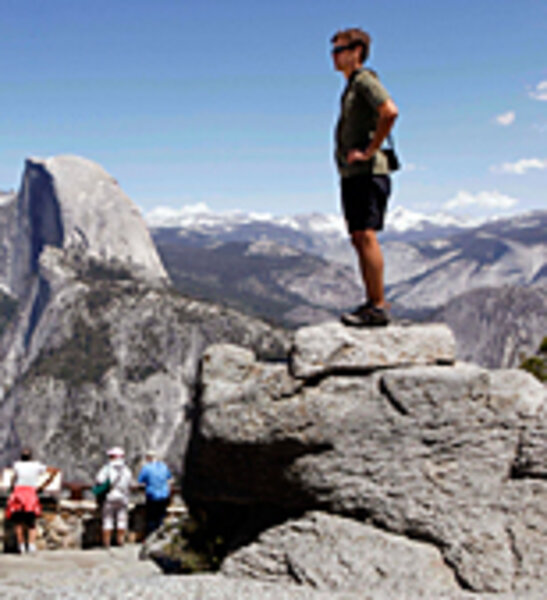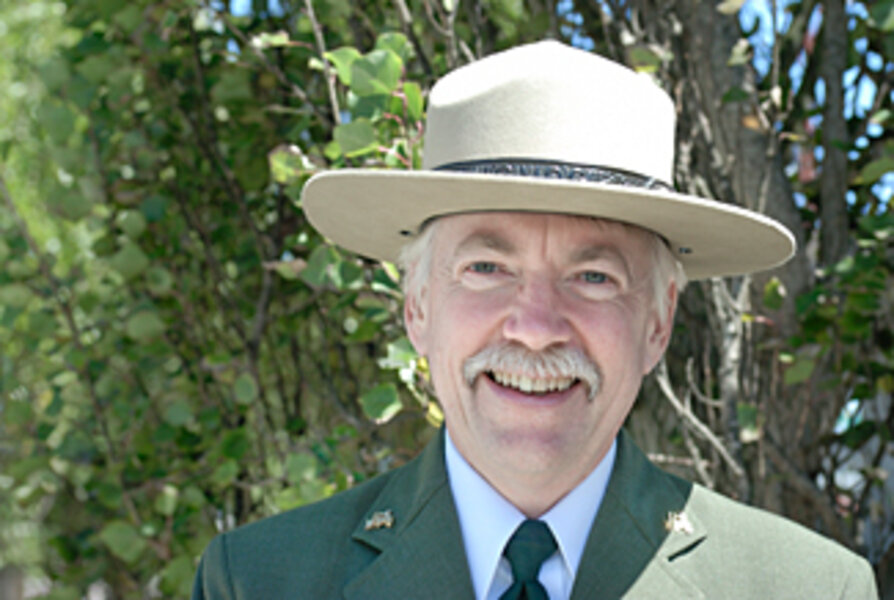Long to-do list for new US parks chief
Loading...
| Yellowstone National Park, Wyo.
Jonathan Jarvis assumed the helm of America's national parks this month, but not before he made two important pilgrimages.
The first was to the home of 19th-century conservationist John Muir, in Martinez, Calif. "I stood under the trees Muir planted and hoped some of his wisdom would find me in the shade," Mr. Jarvis says of the man who helped turn national parks into a worldwide phenomenon.
The second was to Yosemite National Park, where the new park service director, his wife, and two adult children made an arduous trek up the back side of Half Dome ridge. No rangers were allowed to accompany their new boss and smooth his way to the top, per edict of daughter Leah. Each one lugged his or her own pack.
The kids wanted some "private 'dad time,' " Jarvis recalls in a phone interview, "and they didn't want me talking shop" with park personnel. The Jarvis family regards camping trips almost as sacred events. "I guess we're really no different from millions of other families."
That reverence for the vision of yore and for having a national park system available to all Americans today, rich or poor, is what has inspired this 32-year veteran of the National Park Service in making his own career ascent. He'll no doubt draw on it now as he begins to address pressing challenges facing the park system: sagging morale among some 22,000 grayish-green-clad civil servants out in the field, how to bring appreciation for the national parks to urban dwellers, and the need to catalog the effects of climate change on the parks, to name only a few.
Jarvis knows the park service's problems are epic. Its maintenance backlog is $8 billion, for one, and it is seeking more money from Congress to fill potholes, improve ranger living quarters, and build more visitor centers and campgrounds.
But that pales in comparison with the worries posed by global warming, which Jarvis calls "the greatest challenge ever to face national parks."
Boosting the agency's $2.5 billion annual budget would help bolster scientific research and education efforts about the issue, he says. But more money itself will not fix the threats to parks posed by changed park habitats.
Jarvis says parks could sequester carbon, serve as sanctuaries for species facing extinction, and bring to public attention the ways global warming is transforming the environment. For instance, the expected melting of all the glaciers in Glacier National Park in Montana within three decades isn't merely about the loss of postcard-perfect photos; it has implications for fresh water used by humans and wildlife miles downstream, he says.
His first priority, Jarvis says, is to ensure that peer-reviewed science plays a foundational role in management decisions, especially in confronting climate change.
He has enlisted a special science adviser, Gary Machlis, to provide a science-based analysis whenever dealing with the tug of war between protecting and tapping park resources. Mr. Machlis's instructions are to resolidify park service ties with the prestigious National Academy of Sciences.
That's not too surprising, given Jarvis's background: He is the first park service director to be trained as a biologist.
That's a symbolic and important distinction, says Denis Galvin, a retired park service policy veteran who has known 10 different directors. It's one reason Jarvis has worn his "greenness" on his sleeve – even at times when public display of environmental sensibility was frowned upon in Washington.
During his career, Jarvis has backed removal of dams blocking salmon streams near Olympic National Park in Washington. He reduced development around Crater Lake National Park in Oregon to improve water quality. And he got into hot water recently with US Sen. Dianne Feinstein (D) of California for fighting a commercial oyster operation in a bay at Point Reyes National Seashore because he believed it would harm the marine ecosystem.
During his recent tenure as regional director overseeing national parks in California, Oregon, Washington, Nevada, and Idaho, Jarvis criticized attempts to weaken park protection codes, end public education programs, and outsource ranger jobs to the private sector.
"He has credibility [among resource professionals] not only because he spoke out, but because he came up inside, through the ranks. He's not an outsider," Mr. Galvin says. "He knows the agency culture, its traditions, and its mandate for the American people. He didn't buckle under."
Jarvis is praised by the Coalition of National Park Service Retirees, which blanched when parks became political footballs in controversies ranging from reducing the number of snowmobiles in Yellowstone to attempts by Creationists to sell books on the rim of the Grand Canyon.
His record, though, is not universally acclaimed, especially among libertarian, small-government proponents in the West.
Chuck Cushman, leader of the American Land Rights Association, which has fought park expansion efforts in the past, recently wrote: "Now, with Jon Jarvis in charge of the Park Service, the National Parks Conservation Association and their green allies have their best chance yet for an enormous park expansion plan, huge buffer zones around every park, and a multibillion-dollar land acquisition trust fund."
In a way, Jarvis sees his return to the nation's capital as a homecoming. His father worked for the Civilian Conservation Corps during the Great Depression. Young Jon grew up in Virginia's Shenandoah Valley, explored the Blue Ridge Parkway, and "hunted and fished and climbed every mountain within sight of our door." His older brother, Destry Jarvis, is a professional conservationist.
Their parents taught them that the caretaking of natural resources is an honorable calling. Upon graduating from the College of William and Mary, in Williamsbug, Va., Jarvis toured the signature parks in the West – Yellowstone, Grand Teton, Glacier, North Cascades, and Zion – and knew he wanted to work in them. He now reports to Interior Secretary Ken Salazar. His office is within easy reach of the National Mall, where Jarvis started his career in 1976 as a seasonal ranger handing out tourist maps.
"I like to tell people that back in those days parks were 'bigger' because the landscapes around them were more rural and wild," Jarvis says. "Today, we have development not only encircling our crown-jewel nature preserves, but look at some of the Civil War battlefields that basically are now in the middle of suburbs."
Wherever he has gone, friends say, Jarvis has courted relationships with local people and ethnic groups who haven't always felt welcome in parks. The fledgling director says he shares Secretary Salazar and President Obama's conviction that parks can be important places where young people can give back to their country through volunteer efforts or in domestic versions of foreign service.
PBS's recent popular series "The National Parks: America's Best Idea," Jarvis says, demonstrated that the system's evolution and "is not just a white guy's story." The addition of important civil rights sites and urban parks offers a lens for discovery to all citizens, no matter what their ancestry.
The US park system – now with 391 parks, monuments, reserves, and other environmental treasures – turns a century old in 2016.•






